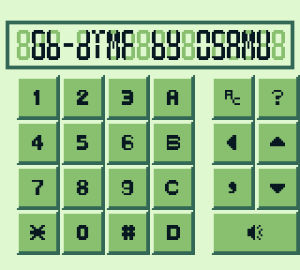More actions
(Created page with "{{Infobox GB Homebrews |title=GB-DTMF |image=gbdtmf.png |description=A homebrew that demonstrate DTMF (Dual-Tone Multi-Frequency) system in telecommunication. |author=Osamu Ohashi |lastupdated=2000/05/27 |type=Other Apps |version=1.0 |format=DMG |license=MIT |download=https://dlhb.gamebrew.org/gbhomebrews/gbdtmfgenetatorgb.7z |website=https://web.archive.org/web/20000916035310/http://members.tripod.com/~TeamKNOx/gameboy/gb_softe.html |source=https://gitlab.com/teamknox/g...") |
No edit summary |
||
| (2 intermediate revisions by the same user not shown) | |||
| Line 7: | Line 7: | ||
|type=Other Apps | |type=Other Apps | ||
|version=1.0 | |version=1.0 | ||
|license=MIT | |||
|format=DMG | |format=DMG | ||
|download=https://dlhb.gamebrew.org/gbhomebrews/gbdtmf.7z?k33p0fil35 | |||
|download=https://dlhb.gamebrew.org/gbhomebrews/ | |||
|website=https://web.archive.org/web/20000916035310/http://members.tripod.com/~TeamKNOx/gameboy/gb_softe.html | |website=https://web.archive.org/web/20000916035310/http://members.tripod.com/~TeamKNOx/gameboy/gb_softe.html | ||
|source=https://gitlab.com/teamknox/gbcdtmf | |source=https://gitlab.com/teamknox/gbcdtmf | ||
}} | }} | ||
{{#seo: | {{#seo: | ||
| Line 29: | Line 28: | ||
Here's the standard layout of a DTMF keypad: | Here's the standard layout of a DTMF keypad: | ||
------------------- | |||
| 1 | 2 | 3 | A | | | 1 | 2 | 3 | A | | ||
------------------- | |||
| 4 | 5 | 6 | B | | | 4 | 5 | 6 | B | | ||
------------------- | |||
| 7 | 8 | 9 | C | | | 7 | 8 | 9 | C | | ||
------------------- | |||
| * | 0 | # | D | | | * | 0 | # | D | | ||
------------------- | |||
In DTMF signaling, the letters A, B, C, and D are used as part of the keypad layout, along with the numbers 0 to 9, to generate specific frequency combinations. DTMF is the tone-based system used in telecommunication to send digits, numbers, and some special characters over telephone lines. | In DTMF signaling, the letters A, B, C, and D are used as part of the keypad layout, along with the numbers 0 to 9, to generate specific frequency combinations. DTMF is the tone-based system used in telecommunication to send digits, numbers, and some special characters over telephone lines. | ||
Latest revision as of 04:55, 4 February 2024
| GB-DTMF | |
|---|---|
 | |
| General | |
| Author | Osamu Ohashi |
| Type | Other Apps |
| Version | 1.0 |
| License | MIT License |
| System | DMG |
| Last Updated | 2000/05/27 |
| Links | |
| Download | |
| Website | |
| Source | |
GB-DTMF is a a Dual Tone Multi-Frequency generator for the Game Boy. It was made by Yuichi Oda as an example for non-gaming purpose.
User guide
Dual-Tone Multi-Frequency (DTMF) is a telecommunication system that generates specific tones when phone keys are pressed, used for controlling automated equipment and dialing numbers. These tones are transmitted with the voice channel.
It uses a combination of two specific audio frequencies to represent each digit, allowing users to input numbers and control various features on telecommunication devices, such as touch-tone phones, automated phone systems, and interactive voice response systems.
Here's the standard layout of a DTMF keypad:
------------------- | 1 | 2 | 3 | A | ------------------- | 4 | 5 | 6 | B | ------------------- | 7 | 8 | 9 | C | ------------------- | * | 0 | # | D | -------------------
In DTMF signaling, the letters A, B, C, and D are used as part of the keypad layout, along with the numbers 0 to 9, to generate specific frequency combinations. DTMF is the tone-based system used in telecommunication to send digits, numbers, and some special characters over telephone lines.
When you press a key on a DTMF keypad, it generates two specific frequencies at the same time, one from the row and one from the column of the pressed key. These frequencies are used to encode the specific symbol (number, letter, or special character) associated with that key.
For example, pressing the "2" key generates a combination of frequencies 697 Hz and 1336 Hz. The letter "A" corresponds to the combination of frequencies 697 Hz and 1633 Hz. Similarly, other letters and special characters are associated with their respective frequency combinations according to the DTMF standard.
External links
- Author's website - http://members.tripod.com/~TeamKNOx/ (archived)
- GitLab - https://gitlab.com/teamknox/gbcdtmf
